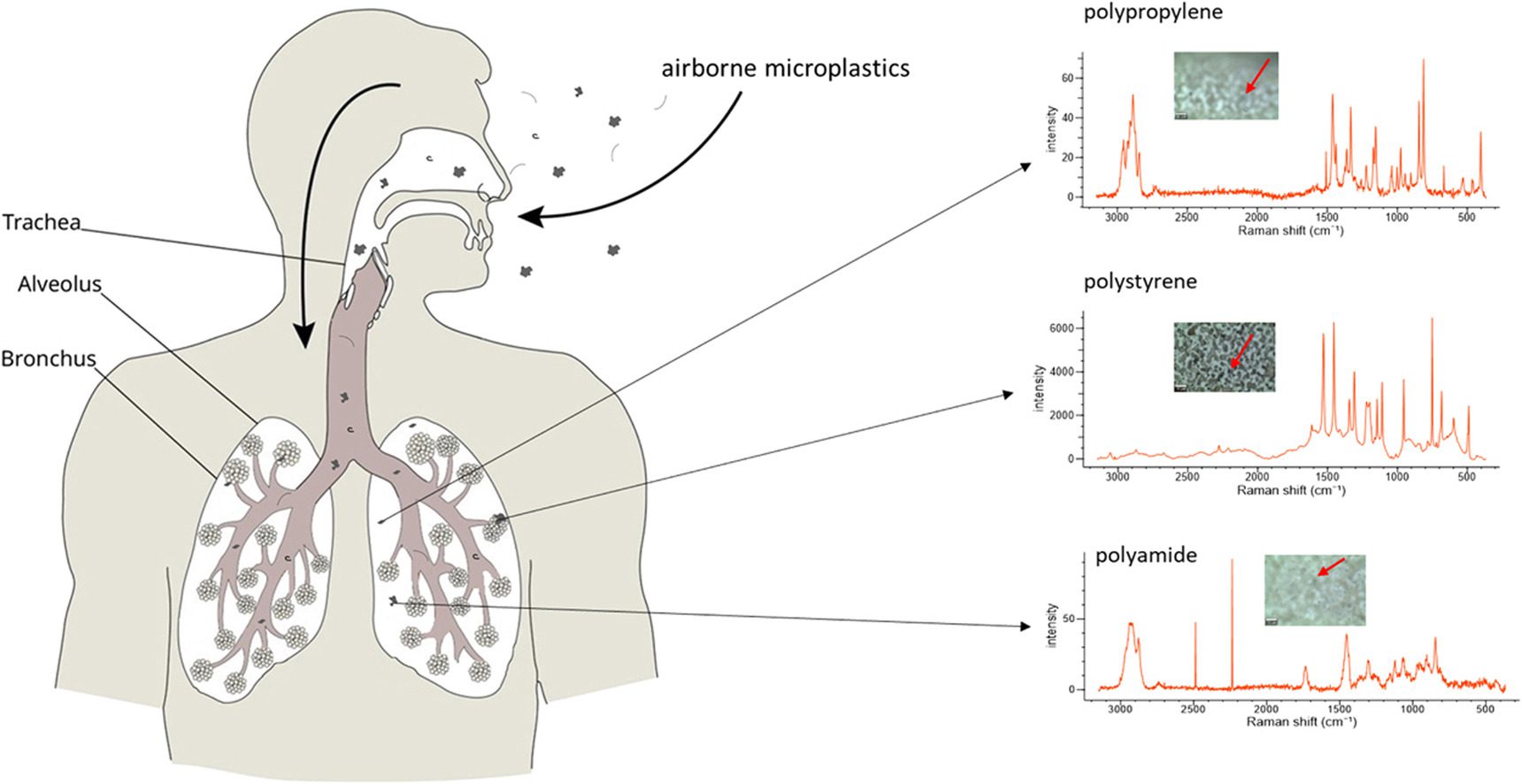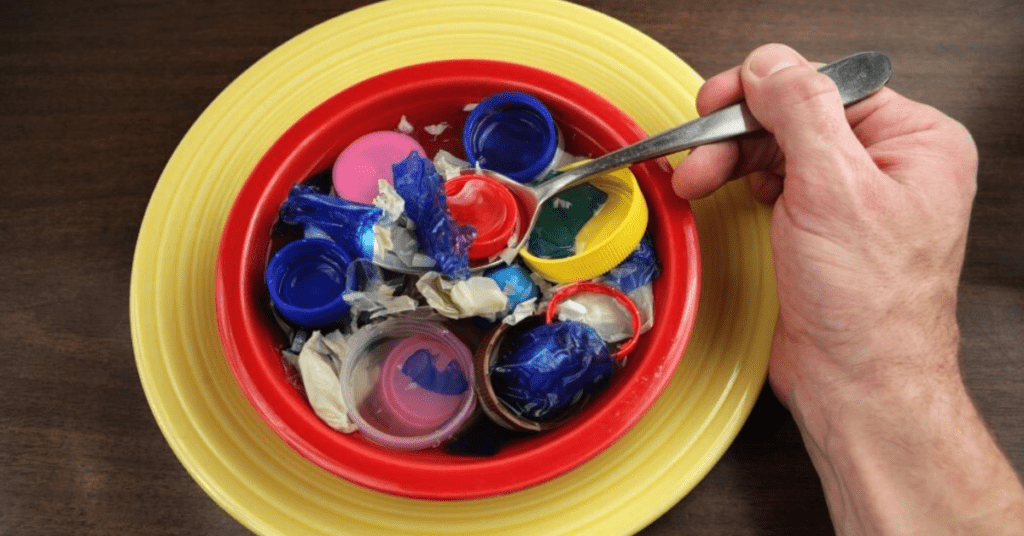Discover the latest studies which indicate the presence of microplastics within the human body, as well as the potential impact of these microplastics on human health.
Microplastics are small plastic particles measuring less than 5mm in size, and are found in a wide range of environments, including oceans, rivers, lakes, soil, and even in the air. They are found in different forms such as fibers, beads, and fragments, and are often derived from larger plastic items that have broken down due to environmental factors, such as UV radiation and wave action.
HOW DO MICROPLASTICS REACH OUR BODIES ?
The issue of microplastics (MPs) and their harmful effects on both fish and humans is a growing concern worldwide. Microplastics can enter the human body through various pathways. The most common pathway is ingestion, as humans consume microplastics through contaminated food and water, especially fish and seafood, which has been shown to accumulate microplastics.[1] Since fish is a crucial source of protein for human consumption, its contamination by MPs is a major hazard that requires special attention. Exposure to MPs alone or in combination with other pollutants can cause various health issues in fish, including tissue damage, oxidative stress, and changes in immune-related gene expression. Furthermore, fish may suffer from neurotoxicity, growth retardation, and behavioral abnormalities after exposure to MPs[2]. Microplastics can also be present in drinking water, both from bottled and tap sources. Once ingested, microplastics can pass through the digestive system and reach various organs and tissues, including the liver, lungs, and brain.[3]
Inhalation is another pathway of exposure to microplastics. Microplastics can be present in the air we breathe, particularly in urban areas and indoor environments. Microplastics in the form of fibers and particles can enter the respiratory system, leading to potential health risks.[4]
Skin contact is another possible pathway for microplastic exposure. Microplastics can be found in personal care and cosmetic products, such as exfoliating scrubs and toothpaste. When applied to the skin, these products can release microplastics that can enter the body through absorption or ingestion.
The entry of microplastics into the human body through various pathways is a growing concern. The potential health risks associated with the exposure to it have not been fully understood, and more research is needed to determine the extent of their impact on human health. However, recent studies detected the presence of microplastics in the most improbable places, leading to a variety of potential negative health effects.
MICROPLASTICS IN HUMAN PLACENTA
A recent study published in the journal Environmental Science and Technology[5] attempted to identify the presence of MPs in placental and meconium samples. This is particularly concerning since infants have been shown to be potentially more exposed to MPs than adults. Previous research has shown that polystyrene nanoparticles can cross the placental barrier and enter fetal tissues from maternal lungs in mammals[6]. However, there is still a lack of human evidence on the potential effects of placental microbiota changes on the metabolism of the mother-fetus unit, gestational diabetes mellitus, or adverse pregnancy outcomes, such as low birth weight or preterm birth. The fetal and early neonatal microbiome depend on the maternal microbiome in the placenta, amniotic fluid, and vagina. In a study conducted in China, placental and fetal MPs were examined in 18 mother-infant dyads during pregnancy using a laser infrared imaging spectrometer (LDIR), and microbiota were assessed using 16S rRNA sequencing.[7] These findings indicate a need for further research to better understand the potential risks associated with the exposure to MPs during pregnancy and early life.
MICROPLASTICS IN HUMAN LUNGS
A study[8] from Hull York Medical School aimed to detect and characterize MPs in human lung tissue samples to determine if MPs from the environment can be inhaled, deposited and accumulated within the lungs. The samples were analyzed using μFTIR spectroscopy, and the study identified 39 MPs within 11 of the 13 lung tissue samples.
The levels of MPs within tissue samples were significantly higher than those identified within procedural/laboratory blanks, and the most abundant polymer types identified were polypropylene, polyethylene terephthalate, and resin. MPs were detected in all regions of the lung, with significantly higher levels in the lower region compared to the upper and middle/lingular regions. These results suggest that inhalation is a route of exposure for environmental MPs and may have health impacts.

MICROPLASTICS IN HUMAN BLOOD
Other studies have found microplastics in human blood, which shows that the particles can travel around the body and may lodge in organs[9]. The researchers identified and quantified four high production volume polymers in blood for the first time, including polyethylene terephthalate, polyethylene, polymers of styrene, and poly(methyl methacrylate). The mean concentration of plastic particles in blood was 1.6 µg/ml, indicating that plastic particles are bioavailable and can enter the human bloodstream. While the study was conducted on a small number of donors, it highlights the need for further research to determine the public health risks associated with plastic particle exposure.
MICROPLASTICS IN BREAST MILK
A recent study[10] has found microplastics in human breast milk for the first time. Researchers at the Universita Politecnica della Marche in Italy analyzed breast milk samples from 34 healthy mothers, and microplastics were detected in 26 of the samples, which means 76% of them. The microplastics were made up of polyethylene, polypropylene, and polyvinyl chloride, which are found in plastic packaging, with sizes ranging from 2 to 12 micrometers. Pregnant women were advised to pay attention to the food and drinks they consume in plastic packaging, clothes made with synthetic fabrics, and cosmetics that contain microplastics. The study raises public awareness to pressure politicians to promote laws that reduce pollution.
THE HEALTH RISK RELATED TO MICROPLASTICS
Microplastics have been found to contain a variety of toxic chemicals, such as bisphenol A (BPA) and polychlorinated biphenyls (PCBs). These chemicals can leach out of the plastic and be absorbed by the body, potentially leading to a wide range of health problems. Studies have found that exposure to these chemicals can disrupt the endocrine system, leading to developmental and reproductive problems, as well as cancer and other diseases. Microplastics also absorb and concentrate pollutants from the environment, such as persistent organic pollutants (POPs). When ingested, these pollutants can accumulate in the body, leading to a wide range of health problems, including cancer, developmental and reproductive problems, and damage to the immune and nervous systems. [11]
It is also suggested in the same study that certain types of microplastics may contain carcinogenic (cancer-causing) substances, such as bisphenol A (BPA) and phthalates. These chemicals are known to mimic hormones in the body and disrupt normal hormone function.
Microplastics can also cause physical damage to the skin, leading to irritation, allergies and other problems. Microplastics can also contribute to the aging of the skin by causing damage to the collagen, a protein that gives skin its elasticity and firmness.
There is extensive research on the impact of pollutants found in plastics, as well as on various respiratory illnesses such as asthma, chronic obstructive pulmonary disease (COPD), and cancer, which claim the lives of millions of individuals each year and have been associated with exposure to other contaminants. According to the most recent report by the American Lung Association, COPD, which is caused by chronic inflammation, is now the fourth leading cause of death in the United States. Human beings inhale numerous foreign particles on a daily basis, a phenomenon that has been occurring since the beginning of the Industrial Revolution. The body’s initial reaction is to seek out a means of expelling them. Larger particles in the airways are usually coughed up, while mucus is produced around particles deeper in the respiratory system, creating a mucus “elevator” that propels them back up to the upper airway for elimination. Immune cells surround any remaining particles to isolate them.
A GROWING ISSUE THAT REQUIRES URGENT SOLUTIONS
It is important to note that this is a new area of research and more research is needed to understand the potential health impacts of microplastics on human health. However, it is crucial to reduce exposure to microplastics as much as possible by reducing single-use plastics, properly disposing of plastics, choosing products that don’t contain microplastics, and properly disposing of trash to prevent it from ending up in oceans and other environments. But most importantly, the need to shield our waters from this threat has never been more urgent. Fortunately, new technologies like Ascandra, our microfluidics-based microplastic remediation device, have the potential to play a critical role in addressing this problem. With the ability to remove microplastics from water more efficiently and effectively than existing methods, Ascandra can help tackle this issue of microplastics and shield our waters from microplastics.
By deploying innovative technologies like Ascandra, we can take significant strides towards safeguarding our oceans and preserving our planet for future generations.
References
[1] Rochman, C. M., et al. . Anthropogenic debris in seafood: Plastic debris and fibers from textiles in fish and bivalves sold for human consumption. Scientific Reports, 5, 1-7. (2015)
[2] Bhuyan, Md. Effects of Microplastics on Fish and in Human Health. Frontiers in Environmental Science. 10. 1-17. (2022)
[3] Wagner, M., & Oehlmann, J. Endocrine disruptors in bottled mineral water: Estrogenic activity in the E-Screen. Int J Hyg Environ Health, 220(2), 323-326. (2017)
[4] Gualtieri, M., et al. (2021). Inhaled micro- and nanoplastics damage lung and liver tissues and impair energy metabolism in rats. Nature Communications, 12(1), 1-13.
[5] https://pubs.acs.org/doi/10.1021/acs.est.2c04706
[6] Wang, Y., Li, J., Wei, X., Wang, Y., & Li, HMicroplastics in human placenta and meconium: A proof-of-concept study. Environmental Science & Technology, 55(16), 10645-10653. .(2021).
[7] Liu S, Liu X, Guo J, Yang R, Wang H, Sun Y, Chen B, Dong R. The Association Between Microplastics and Microbiota in Placentas and Meconium: The First Evidence in Humans. Environ Sci Technol. (2022)
[8] Lauren C. Jenner, Jeanette M. Rotchell, Robert T. Bennett, Michael Cowen, Vasileios Tentzeris, Laura R. Sadofsky, Detection of microplastics in human lung tissue using μFTIR spectroscopy, Science of The Total Environment,Volume 831, (2022)
[9] Casillas, G.; Hubbard, B.C.; Telfer, J.; Zarate-Bermudez, M.; Muianga, C.; Zarus, G.M.; Carroll, Y.; Ellis, A.; Hunter, C.M. Microplastics Scoping Review of Environmental and Human Exposure Data. Microplastics (2023)
[10] Ragusa, A.; Notarstefano, V.; Svelato, A.; Belloni, A.; Gioacchini, G.; Blondeel, C.; Zucchelli, E.; De Luca, C.; D’Avino, S.; Gulotta, A.; Carnevali, O.; Giorgini, E. Raman Microspectroscopy Detection and Characterisation of Microplastics in Human Breastmilk. Polymers (2022)
[11] Campanale C, Massarelli C, Savino I, Locaputo V, Uricchio VF. A Detailed Review Study on Potential Effects of Microplastics and Additives of Concern on Human Health. Int J Environ Res Public Health. (2020)

Nour Chebbi
Head Of Marketing
M.Sc. Microfluidics

